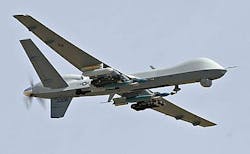Air Force kicks off sensor-fusion program to help UAVs sense and avoid other aircraft in shared airspace
WRIGHT-PATTERSON AFB, Ohio, 18 July 2012. U.S. Air Force researchers are surveying industry for companies able to develop sensor-fusion technology that enables unmanned aerial vehicles (UAVs) to sense and avoid other aircraft while flying in controlled U.S. airspace.
The Air Force Aeronautical Systems Center (ASC) at Wright-Patterson Air Force Base in Dayton, Ohio, has released a sources-sought notice (FA8620-12-X-0001) in anticipation of releasing a request for proposals (RFP) for the Airborne Sense and Avoid (ABSAA) program.
ABASSA seeks to develop a sensor- and platform-agnostic sensor-fusion product for a wide variety of UAVs that will enable these unmanned aircraft to operate safely alongside other manned and unmanned aircraft by sensing and avoiding other aircraft to prevent mid-air collisions. The ABASSA product will have software and hardware interfaces necessary to be sensor and platform agnostic.
Sensors will connect to the sensor-fusion product, then to the UAV's flight controls and operator interface. The initial phase of the ABASSA program will use traffic alert and collision avoidance system (TCAS), automatic dependent surveillance - broadcast (ADS-B), radar, and electro-optical/infrared (EO/IR) input while allowing easy integration of other sensor types in the future.
The first UAV to receive ABASSA technology will be the RQ-4 Global Hawk, yet the system will be scalable to accommodate all kinds of UAVs in the future. ABSAA will provide follow-on capabilities for sense and avoid as demonstrated earlier by the Multiple Intruder Avoidance Algorithm (MIAA) program, conducted by the Air Force Research Lab (AFRL), Air Force officials say.
Companies interested should respond no later than 3 Aug. 2012 with statements of capabilities containing no classified information. Submit responses by e-mail to Air Force Capt. Chris Hearl at [email protected]. No contracts will result from this sources-sought notice.
For questions or concerns contact Mathias Kohnen, the ABASSA lead engineer, by phone at 937-656-7855, or by e-mail at [email protected]. Also contact Paul Schaeffer, the ABASSA program manager, by hone at 937-255-9219 or by e-mail at [email protected].
More information is online at https://www.fbo.gov/spg/USAF/AFMC/ASC/FA8620-12-X-0001/listing.htm
Follow Military & Aerospace Electronics and Avionics Intelligence news updates on Twitter

